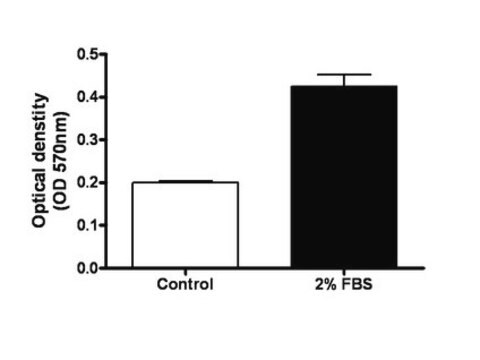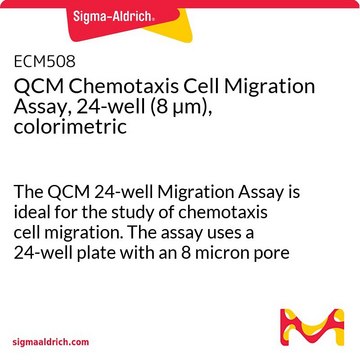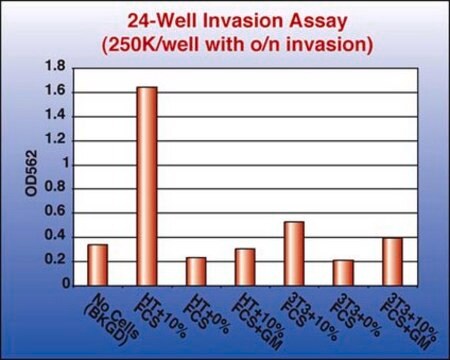17-10191
Cell Comb™ Scratch Assay
Synonim(y):
Cell layer wound repair assay
About This Item
Polecane produkty
producent / nazwa handlowa
Cell Comb™
Chemicon®
QCM
Poziom jakości
metody
activity assay: suitable
cell based assay: suitable
western blot: suitable
Warunki transportu
ambient
Opis ogólny
Click Here!
Cell migration can be studied by a variety of methods, but the scratch assay remains a highly popular method due to the simplicity of the required materials, experimental setup, data collection and interpretation (Lian, C., et al., 2007; Cory, G., 2011). The scratch assay is typically initiated by scratching a confluent cell monolayer with a pipette tip to create a narrow wound-like gap. Shortly after wounding, the cells at the edge of the wound initiate a program to migrate into the gap, a process that continues until the gap has been completely repopulated with cells. Extent of wound closure is typically observed through light microscopy and protein expression patterns that occur during the wound healing process can be characterized by immunofluorescence.
Advances in understanding the repair mechanisms of wounded cell monolayers have been facilitated by the development of methods for performing the assay in multiwell plates. Such methods include delivering wounds to existing monolayers in the wells, or occlusion of the center of the well during monolayer formation to create a gap (Yarrow, J.C., et al., 2004; Simpson K.J., et al., 2008; Gough, W., et al., 2011). Each method then involves quantification of the extent of cell migration into the gap.
However, these methods are not optimal for biochemical analysis of the molecular events mediating wound repair. For example, the small scale of a basic pipette tip-derived wound provides insufficient and inadequate material for biochemical analysis. Using the same pipette tip to scratch a cell monolayer in a larger plate is tedious and irreproducible, and the proportion of migrating cells to quiescent cells is low. Several methods have been described to scale up the scratch assay by creating multiple wounds in cell monolayers but these methods require specialized tools (Turchi, L., et al., 2002; Lauder, H., et al., 1998).
EMD Millipore has developed the Cell Comb™ Scratch Assay to address the need for an easy-to-use tool for creating multiple scratch wounds. The patent pending Cell Comb<TMSYMBOL></TMSYMBOL> has been optimized to apply a high density field of scratches to maximize the area of wound edges, while leaving sufficient numbers of undamaged cells to migrate into the gap. This form of high density wounding creates a high proportion of migrating cells to quiescent monolayer cells, which permits sensitive detection of the biochemical events occurring, specifically in the migrating cell population.
Zastosowanie
Cell Structure
Opakowanie
Komponenty
Rectangular Cell Culture Plates: Quantity of 6 individually packaged, cell culture-treated 86 mm x 128 mm plates.
The Cell Combs and Cell Culture Plates have been subjected to E-beam irradiation in order to minimize the possibility of contamination.
Przechowywanie i stabilność
Informacje prawne
Oświadczenie o zrzeczeniu się odpowiedzialności
Kod klasy składowania
10 - Combustible liquids
Certyfikaty analizy (CoA)
Poszukaj Certyfikaty analizy (CoA), wpisując numer partii/serii produktów. Numery serii i partii można znaleźć na etykiecie produktu po słowach „seria” lub „partia”.
Masz już ten produkt?
Dokumenty związane z niedawno zakupionymi produktami zostały zamieszczone w Bibliotece dokumentów.
Produkty
Testy angiogenezy oparte na komórkach do analizy tworzenia nowych naczyń krwionośnych do zastosowań w badaniach nad rakiem, regeneracji tkanek i biologii naczyniowej.
Nasz zespół naukowców ma doświadczenie we wszystkich obszarach badań, w tym w naukach przyrodniczych, materiałoznawstwie, syntezie chemicznej, chromatografii, analityce i wielu innych dziedzinach.
Skontaktuj się z zespołem ds. pomocy technicznej








